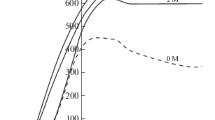Abstract
The results of investigations of the electrochemical behaviour of multicomponent lead–tin alloys under cathodic polarization in a sodium hydroxide melt are presented. It has been shown that as a result of the formation of intermetallic compounds, such elements as antimony, tin, bismuth and arsenic are extracted from the cathode to the anode. The electrolysis product on the cathode is lead with a total percentage of the above impurities of 0.065–0.070%. The extraction kinetics have been studied, the dissolution rate constants for each of the alloy components have been determined and a mechanism of mass exchange between the electrodes has been proposed. The current consumption for the extraction of metals from the melt has been determined.
Similar content being viewed by others
References
W.H. Dennis, ‘Metallurgy of Non-ferrous Metals’ (Pitman, London, 1961).
P. Paschen and H. Winterhager, Z. Erzbergbau und Metallhüttenwesen 21 (1968) 14.
T.R.A. Davey, J. Metals 8(3) (1956) 341.
O.G. Zarubitskii, A.P. Dugelnyi, A.A. Omelchuk, V.Y. Dyakov and V.T. Melyokhin, Tsvet.Metally 3 (1991) 30 (in Russian).
Y.K. Delimarskii and O.G. Zarubitskii, ‘Electrorefining of Heavy Nonferrous Metals in Melts’ (Metallurgiya, Moscow, 1975), (in Russian).
O.G. Zarubitskii, ‘Refining of Metals in Alkali Melts’ (Metallurgiya, Moscow, 1981), (in Russian).
O.G. Zarubitskii and N.F. Zakharchenko, Bull. Bismuth Institute 21 (1978) 5.
W.T. Denholm, R. Dorin and H.J. Gardner, in M.J. Bones (Ed.), ‘Advances in Extractive Metallurgy and Refining’ (IMM, London, 1977), p. 239.
C. Grange and L. Heerman, J.Appl.Electrochem. 4 (1974) 279.
V.S. Lovchikov, ‘Alkali Refining of Lead’ (Metallurgiya, Moscow, 1964), (in Russian).
V.P. Glushko (Ed.), ‘Thermodynamic Constants of Substances’, issue X, part 1 (Moscow, 1981), (in Russian).
M. Hansen and K. Anderko, ‘Constitution of Binary Alloys’, 2nd edn (McGraw-Hill, New York, 1958).
Author information
Authors and Affiliations
Corresponding author
Rights and permissions
About this article
Cite this article
Omelchuk, A., Zarubitskii, O., Opanasyuk, V. et al. Behaviour of multicomponent lead–tin alloys under cathodic polarization in a sodium hydroxide melt. Journal of Applied Electrochemistry 33, 519–524 (2003). https://doi.org/10.1023/A:1024422821777
Issue Date:
DOI: https://doi.org/10.1023/A:1024422821777




